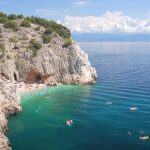Do you know where you’re allowed to run around in your birthday suit along the Croatian coast?
Did you know that one in ten tourists like to swim in the Adriatic naked? While this research was conducted several years ago, this would mean that there are one million tourists who like to bathe in their birthday suits during their Croatian vacation.
Because it’s summer, it’s hot, and we all probably wish we were full-time naturists by this point in the season, do you know what the Adriatic offers naturists today? Slobodna Dalmacija reports on July 22, 2017.
Put quite simply, not nearly as much as the European nudist superpower of Croatia offered some 50 years ago. Instead of a coastline full of nude hotels and campsites, today, the Adriatic tourist book intended for naturists can be read in a few pages.
And we mean this quite literally, because there are only two tourist accommodation facilities in Dalmatia, from Zadar to Dubrovnik, that are officially registered and can receive naturists, and are therefore being promoted. Everything else has been switched off, closed down, or swept away, along with the spike of naturists visiting Croatia, which is less each year.
It once was that you couldn’t visit an area along the Adriatic coast without having an option for naturists. From Rovinj, Vrsar, Zadar, the Šibenik islands, Hvar, Slano, Mlini, Cavtat, and Lokrum, there was almost no strong tourist center without a nudist camp or hotel. In 1983, there were roughly 34 nudist camps in Croatia, which could accommodate more than 100,000 naked guests.
One of the most famous among them, Vrsar’s ”Koversada”, one day, could accommodate 17,000 tourists. However, when nudism as a lifestyle without clothing was transformed into naturism, a practice of living in harmony with nature while respecting others and the environment (which boasts around 10 million worshippers around the world), Croatia gave up on the offer.
“The last promotional materials we made for this kind of offer, which we were world-famous for, was some 15 years ago at the Croatian Tourist Board. Since then, there has been nothing, and Minister Lorencin blew out the candle for promoting naturism because he considered that it was not interesting to us.
And we had world glory, recognizability, and quality in hotel facilities and campsites exclusively for nudists. In the middle of the war, they remained the most reliable guests in Istria, and they came during the war in 1992 from Austria and Germany.
In the range of various offers we have, I see no reason why we gave up on the naturists,” said Jerko Sladoljev, a long-time tourist worker who is surely best-known for his role in the “without clothes” movement, as he has been monitoring, analyzing and recording everything about naturism in Croatia for more than half a century.
When asked where here thought the nudism of the Adriatic disappeared to, Sladoljev replied:
“It did not disappear, but we have ignored it. It is all about the numbers, which today show that the Adriatic has three times fewer camps and naturist hotels than it did 35 years ago, and they are mostly in Istria and Kvarner. Dalmatia has given up on naturists.
Croatia was the most well-known country in Europe in this segment of tourism. While others were ‘illegal,’in Croatia, nudists had commercial and registered camps for them only. Italy 30 years ago did not have any naturist camps, and today they have 15, Spain does as well.
The naturist movement is not just about people without clothing, but above all, the ecological consciousness of life with nature. We have decimated capacities in this type of accommodation, yet we have about 3 million naturist overnights a year.
Nowadays, the nakedness of the Adriatic coast essentially stops in Istria – there are seven campsites there, while Kvarner (Cres and Krk) and Dalmatia both only have two.
The most famous among them is the only official naturist camp ‘Nudist’ on Hvar, only one kilometer away from Vrboska. Located on the shore of the area surrounded by forests, overlooking the island of Brač, the camp can accommodate 450 guests, and its 800-meter long rocky beach is exclusively for naturists.
Another naturist camp is ‘Sovinje,’ located just two kilometers from the center of Tkon on the island of Pašman in Zadar County. Boasting three stars, this camp is located in a pine forest by the sea in the south of the island with two sandy beaches, offering accommodation for 200 guests. And that’s it,” Sladoljev continued.
The many bays, coves, rocky shores and other places that occasionally occupy naturists are just wild beaches that are passed on to generations through the voices of naturists. So far as having official FKK (nudist) beaches – we don’t have them.
Istrian tourist entrepreneurs, however, did not give up on naturists – and the region boasts seven large naturist camps with plenty of capacity. The best known and best in Croatia and Europe is certainly “Valalta” in Rovinj, which can accommodate about 3.5 thousand naturists in their campsites and apartments every day.
The “Koversada” camp in Vrsar, whose reputation for naturism began half a century ago, still has one million square feet of naturist accommodations and 7,000 camping spaces today.
“Today, Croatia receives about 30,000 naturists in one day, and Europe’s interest in these kinds of visits can be five times larger, but there is no capacity. In addition, there is no order, because it permits the ‘mixing’ of the dressed and undressed, which is unthinkable.
It is a pity that in Dalmatia we so reluctantly left that market segment, while it is embraced elsewhere in the Mediterranean,” added Sladoljev, who concluded that naturists are great guests that we, unfortunately, chased away from the Adriatic.
Translated from Slobodna Dalmacija










